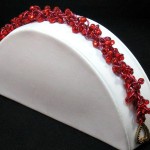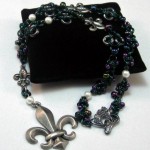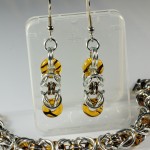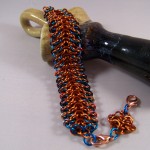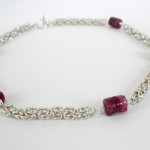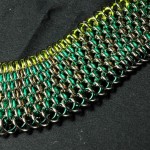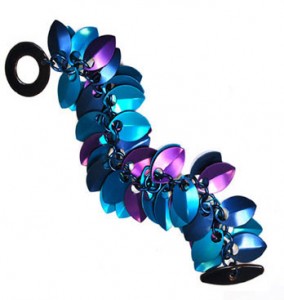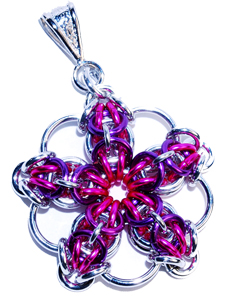
Last week, Rebeca spoke at the Chicago Craft Mafia’s January Craft Racket about getting your work published in magazines and collaborative books, as well as publishing your own crafty book. We hear questions about this all the time (in fact it was the subject of one of our first “Ask an Artist” posts) so we though we’d share the resources she presented at this meeting and open up our blog to comments and questions from maillers and other crafters about getting work published.
Below is part one of a two-part series. This post, along with its FREE downloadable PDF, focuses on getting your work into magazines and multi-authored collaborative books. Part 2 tackles how to get your crafts book published.
 Publishing Your Crafty Project
Publishing Your Crafty Project
By Rebeca Mojica and Lindsay Obermeyer
Getting published in magazines and collaborative (multi-authored) books. Having a single project published in a magazine or book is a great way to get your feet wet with publishing. Obviously it requires far less work and commitment than writing an entire solo-book, and you can get your name out in front of thousands of people who otherwise might never hear of you.
Finding a magazine or book:
There are far too many trade magazines to list here as each industry—beading, woodworking, felting, quilting—has its own publication, and often, multiple publications within the industry. You know your craft well, and so you should know which magazine(s) are appropriate. Some of the biggest craft book publishers include C&T Publishing, Interweave Press, Kalmbach Publishing, Krause, Lark, North Light, Potter Craft, Storey Publishing, Visual. There are dozens more. Go to the bookstore or visit the Crafts & Hobbies section of Amazon.com to get the names of different publishing companies that might be a good fit for your project.
Magazines usually have “submission guidelines” pages on their websites. Sometimes they’ll also include an editorial calendar. Book publishers often post “call for submissions” on their websites.
Before you submit your project
• Familiarize yourself with the magazine (or book publisher) and types of projects they publish. Make sure that your project completely aligns with the techniques their readers are interested in
• Read their submission guidelines. Each company has slightly different requirements; make sure you understand exactly what they require.
• Follow the guidelines! This should go without saying … but you’d be surprised at the number of people who send in low res images instead of hi res images, or who forget to write an introduction to their project.
Submitting your project:
• Write clear step-by-step instructions, using proper grammar. Have someone proofread what you’ve written. Revise, then have someone else proof it. It can be helpful to have both someone familiar with your
craft to proofread, as well as someone who doesn’t know anything about it. It is a great sign if the “outsider” can understand your instructions!
• Take excellent photos for each step of your project. The editors might combine some steps for space reasons, but give them more than enough to work with. Make sure the background is not distracting. It should be a solid color, with no texture. If your hands will be in the shots, get a manicure and make sure your fingernails and hands are smooth (Avoid French manicures; they may look cute in person, but when your finger is magnified for the printed image, it can be very distracting. Also avoid colored nail polish. If you must use polish, use a clear polish, or a color that is close to your natural skin tone. Try to avoid shiny
polish, especially if you are using flash on your camera.) If you are not taking photos and instead are creating illustrations, make sure to also have an illustration for each step of your project.
• Have someone test your instructions
• Triple check the materials list. You want to make sure people will be able to buy exactly what they need to succeed in making your project; if the materials list is incorrect, that will frustrate readers.
• Include your contact info. Most magazines also request a (short) bio and headshot.
• Consider selling kits to make your product. This is a good way to make a little extra money. If you don’t want to deal with the hassle of selling kits, you should be able to tell folks where they can purchase products.
(You may not feel it is your responsibility, but readers will be upset if they come to you and you can’t help them.) For more, read an interview with a former jewelry magazine editor: How Can I Get My Crafts Projects Published?
Obtaining the Necessary Supplies for the Project
Congratulations! Your design idea has been accepted by an editor for inclusion in a book or magazine. Now you need to get started making that project!
Most manufacturers and distributors are willing to supply you with the necessary materials in return for their product being listed. If not, they will at least send it to you at wholesale cost without you having to meet a purchasing minimum. Many companies have designer project request information posted on their websites. If not, give the company a call and ask who would be the best person to submit your query. Usually it is the marketing or education director. Your letter (email) should include your project details, why their product is perfect for what you are doing, and where it will be published.
Vendors get many requests, often from folks wanting to do a project to post on a blog or website, so they frequently will require proof of print publication. Ask your editor if he or she will support you by writing a letter of reference (a letter that includes the name of the magazine or the working title of the book, your name and the project’s working title.) This letter needs to have the editor’s contact information or be on company letterhead. Many editors have established connections and may send you what they want you to use in terms of materials, color and manufacturer.
Remember to send a thank you to the one to assist you. Write this thank you on your finest stationary and post it by mail. Yes, this small step will make you stand out from the crowd and guarantee that when you need help again, they will be happy to assist you. This same advice goes for the editor as well. After all, you want them to accept another of your fabulous projects! 😊

Download part 1 of the FREE “Publishing Your Crafty Project” as a PDF featuring all the information presented in this post, including what to do before and during the submission process as well as how to obtain complimentary or reduced price supplies for your project.

Read Part 2 of the series: Publishing A Crafts Book



